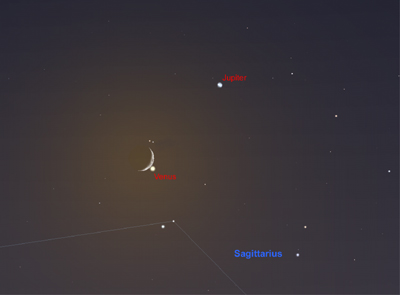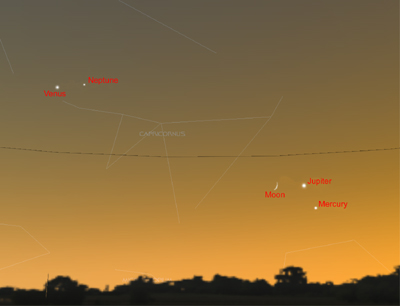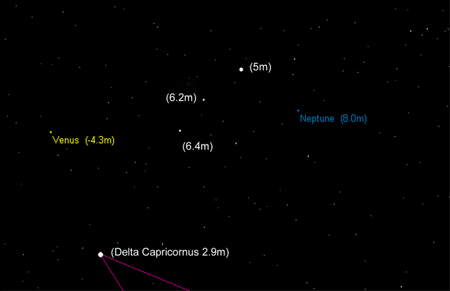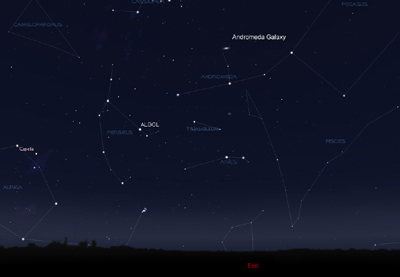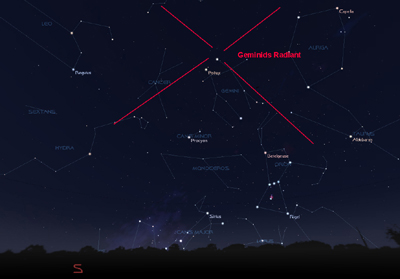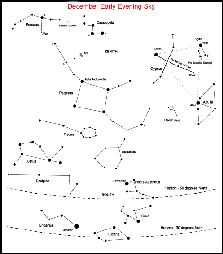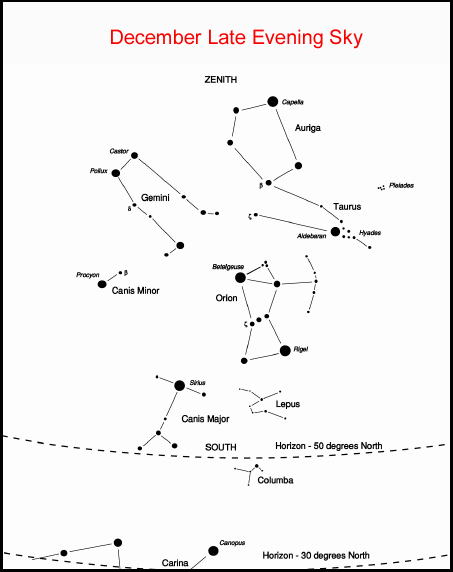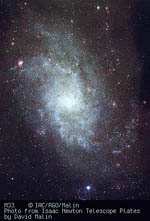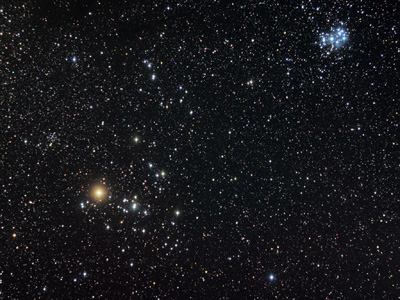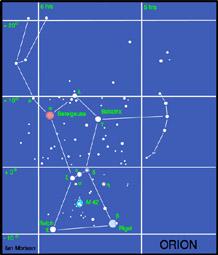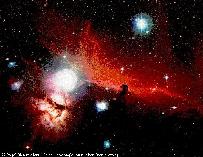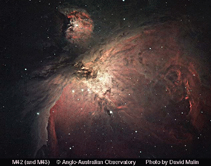The Night Sky December 2008
Compiled by Ian Morison
This page, updated monthly, will let you know some of the things that you can look out for in the night sky. It lists the phases of the Moon, where you will see the naked-eye planets and describes some of the prominent constellations in the night sky during the month.
Image of the Month
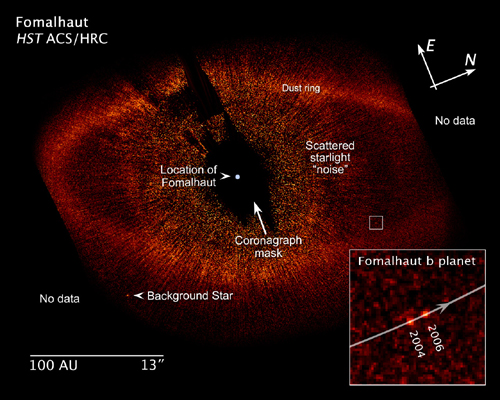
The Hubble telescope spots a planet!
Image: ESA, NASA.
This has to be one of the most exciting images ever captured by the Hubble Space Telescope. For the first time ever, a planet has been seen orbiting a star in visible light. The discovery was based on two observations, in 2004 and 2006, of the star Formalhaut which lies at a distance of 25 light years. An occulting disk was used to prevent much of the starlight falling on the CCD array and so enable the surrounding region to be imaged. As the above image shows, there is a significant dust ring surrounding the star. To the lower right of the star's position was seen a small point of light that moved between the two observations - so indicating that it was a companion planet. It is called Formalhaut b, has a mass of about 3 times that of Jupiter and orbits Formalhaut at a distance of 73 AU.
Highlights of the Month
December 1st: A Lunar Occultation of Venus by a waxing crescent Moon. Jupiter hangs close in the twilight sky.
Jupiter and Venus are 2 degrees of each other on December 1stbut the significant event is that from ~15:44 to ~17:10 Venus is occulted by the thin crescent Moon! The emmersion of Venus will be easy to spot with binoculars, but the immersion in daylight may prove harder. NEVER LOOOK CLOSE TO THE SUN, but the Moon will be ~40 degrees away up to the left at an elevation of 14 degrees. For those with an equatorially mounted telescope it is at a declination of -24 degrees. If this is set on the declination setting circle of a polar aligned mount, then one can sweep across the sky to find it easily. Lets hope that it is clear!
December 29th: The planets line up! Try to spot Neptune too.
The end of the month brings us another very lovely skyscape as Venus, Jupiter and Mercury line up with the crescent Moon. Just 2.5 degrees to the right of Venus is the planet Neptune shining at 8th magnitude. As it gets darker, with Venus still above the horizon, binoculars should be able to pick it out
I have produced a finder chart that should help you find Neptune on the 29th. On any evening around the end of December, though Venus will have moved out of the field of view, the chart would allow you to find Neptune by starting at Delta Capricornus. Good hunting!
Find the Andromeda Galaxy and observe Algol wink!
Late autumn is still a good time to find the Andromeda galaxy. It is near the top of the chart just to the right of centre. Start at the top left star (Alpheratz) of the square of Pegasus, move round two bright stars to the left and up a bit to reach Mirach. At this point turn sharp right, move up one star and then the same distance again. A fainter star is passed and then you should see a fuzzy glow - that is the Nucleus of the Andromeda Galaxy. 10x50 binoculars on a really dark transparent night will show the disk extending out from the nucleus.
To the left of the tiny constellation Triangulum is the Star Algol in Perseus.
It is an eclipsing binary and every 2.87 days its brightness drops by more than a magnitude and then rises again. In December you can watch this happen over a period of hours around 20:17 UT on the 7th and 17:06: UT on the 10th and 18:50 on the 30th.
December 14th after midnight: Perhaps look out for the Geminid Meteor Shower - but the Moon intrudes.
The Geminids
The early morning of December 14th may give us the chance, if clear, of observing the brighter meteors of the Geminid meteor shower. Sadly, this year, the Moon is just one day past full moon and is in Gemini so its glare will obscure most of them. (This couldn't really be worse!) The relatively slow moving meteors arise from debris released from the asteroid 3200 Phaethon. This is unusual, as most meteor showers come from comets. The radiant - where the meteors appear to come from - is close to the bright star Castor in the constellation Gemini as shown on the chart above. If it is clear it will be cold - so wrap up well, wear a woolly hat and have some hot drinks with you. Happily, next year should be better!
Observe the International Space Station

The International Space Station and Jules Verne passing behind the Lovell Telescope on April 1st 2008.
Image by Andrew Greenwood
Use the link below to find when the space station will be visible in the next few days. In general, the space station can be seen either in the hour or so before dawn or the hour or so after sunset - this is because it is dark and yet the Sun is not too far below the horizon so that it can light up the space station. As the orbit only just gets up the the latitude of the UK it will usually be seen to the south, and is only visible for a minute or so at each sighting. Note that as it is in low-earth orbit the sighting details vary quite considerably across the UK. The NASA website linked to below gives details for several cities in the UK. (Across the world too for foreign visitors to this web page.)
Note: I observed the ISS three times in the last week or so of July and was amazed as to how bright it has become.
Find details of sighting possibilities from your location from: Location Index
See where the space station is now: Current Position
The Moon

The Moon at 3rd Quarter. Image, by Ian Morison, taken with a 150mm Maksutov-Newtonian and Canon G7.
Just below the crator Plato seen near the top of the image is the mountain "Mons Piton". It casts a long shadow across the maria from which one can calculate its height - about 6800ft or 2250m.
| new | first quarter | full moon | last quarter |
|---|---|---|---|
| December 27th | December 5th | December 12th | December 19th |
Some Lunar Images by Ian Morison, Jodrell Bank Observatory: Lunar Images
The Planets
Jupiter
Jupiter is seen low down in the south-west as nightfall begins. It lies to the left of the "teapot" in Sagittarius and begins December with an angular size of 34 arc seconds which slowly reduces as the month progresses. In like manner, its brightness slowly reduces from -2.0 magnitudes during the month. However it is now closing in on the Sun's position so will be increasingly lost in the Sunset glare after the first week or so of the month.
Jupiter is now at the lowest point of the ecliptic in the sky and will only be seen about 10-12 degrees elevation above the horizon at nightfall. Thus, sadly, this year our views of Jupiter from northern latitudes have been rather poor. Despite the low elevation, even a small telescope will show the Galilean Moons as they weave their way around it. Due to refraction, we see Jupiter at very slightly different elevations in the different colours of the spectrum, thus bluring the image. A cleaner image may seen if one observes through a narrow band filter such as a green filter or, even better, if you have an 8" scope or above with a filter like an OIII filter only letting a very narrow band of light through.
See the highlights above relating to its conjunctions with Venus and Mercury at the beginning and end of the month!
Saturn
Saturn is now the best placed planet in the sky - but you need to be up late at night or get up early in the morning! It rises around midnight at the beginning of the month, but at ~10:30pm by month's end. It can be seen high in the south-eastern sky in the hours before dawn. Lying below the outline of Leo, it has a magnitude of ~+1 throughout the month. This is significantly less than it often appears as the rings are now, with a tilt of just 1 degree, almost edge on! Soon they will and become invisible to us. Saturn is close to the thin crescent Moon on the 18th and 19th of December.
Mercury
Mercury: will become visible during the last week of December when it rises out of the sunset glare to meet with Jupiter on December 28th. Binoculars will be a useful aid to spotting it. Mercury has a magnitude of -0.7 and an angular size which reaches 6 arc seconds by month's end.
See the highlight above.Mars
Mars lies so close to the Sun this month that it cannot be observed.
Venus
Venus can be seen low in the west after sunset shining at magnitude -4.2 so it is possible to spot it without the use of binoculars. It is gradually moving further in angle from the Sun and so remains in the evening sky for longer after the Sun has set. As the month progresses its brightness increases fractionally to a magnitude of -4.4. It starts December with an angular size of 16.5 arc seconds. By the end of the month, the angular size has increased to 19.2 arc seconds, but the percentage thzt is illuminated will have dropped. These two effects tend to cancel out in the way they affect its apparent brightness which is why the brightness remains almost constant for several months. Venus is moving to a higher declination in the sky now, which is why it is far more prominent than it has appeared for some time. See highlights above.
Find more planetary images and details about the Solar System: The Solar System
The Stars
The Early Evening December Sky
The Late Evening December Sky
This maps shows the constellations seen towards the south in early and late evening. Setting towards the west in early evening is the beautiful region of the Milky Way containing both Cygnus and Lyra. Below is Aquilla. The three bright stars Deneb (in Cygnus), Vega (in Lyra) and Altair (in Aquila) make up the "Summer Triangle". East of Cygnus is the great square of Pegasus - adjacent to Andromeda in which lies M31, the Andromeda Nebula. To the north lies "w" shaped Cassiopeia and Perseus. The lower map shoesthe constellation Taurus, with its two lovely clusters, the Hyades and the Pleaides, and is also described in more detail below. as the evening draws on, Orion, the Hunter, follows Taurus into the eastern sky with the constellations Auriga, above, and Gemini, to the upper left. Later Sirius, in Canis Major will be seen to the lower left of Orion. Due to its brightness and scintillations caused by the atmosphere it often appears as a rainbow of colours flashing in the sky.
The constellations Lyra and Cygnus
This month the constellations Lyra and Cygnus are seen almost overhead as darkness falls with their bright stars Vega, in Lyra, and Deneb, in Cygnus, making up the "summer triangle" of bright stars with Altair in the constellation Aquila below. (see sky chart above)
Lyra
Lyra is dominated by its brightest star Vega, the fifth brightest star in the sky. It is a blue-white star having a magnitude of 0.03, and lies 26 light years away. It weighs three times more than the Sun and is about 50 times brighter. It is thus burning up its nuclear fuel at a greater rate than the Sun and so will shine for a correspondingly shorter time. Vega is much younger than the Sun, perhaps only a few hundred million years old, and is surrounded by a cold,dark disc of dust in which an embryonic solar system is being formed!
There is a lovely double star called Epsilon Lyrae up and to the left of Vega. A pair of binoculars will show them up easily - you might even see them both with your unaided eye. In fact a telescope, provided the atmosphere is calm, shows that each of the two stars that you can see is a double star as well so it is called the double double!
Between Beta and Gamma Lyra lies a beautiful object called the Ring Nebula. It is the 57th object in the Messier Catalogue and so is also called M57. Such objects are called planetary nebulae as in a telescope they show a disc, rather like a planet. But in fact they are the remnants of stars, similar to our Sun, that have come to the end of their life and have blown off a shell of dust and gas around them. The Ring Nebula looks like a greenish smoke ring in a small telescope, but is not as impressive as it is shown in photographs in which you can also see the faint central "white dwarf" star which is the core of the original star which has collapsed down to about the size of the Earth. Still very hot this shines with a blue-white colour, but is cooling down and will eventually become dark and invisible - a "black dwarf"! Do click on the image below to see the large version - its wonderful!
M56 is an 8th magnitude Globular Cluster visible in binoculars roughly half way between Alberio (the head of the Swan) and Gamma Lyrae. It is 33,000 light years away and has a diameter of about 60 light years. It was first seen by Charles Messier in 1779 and became the 56th entry into his catalogue.
Cygnus
Cygnus, the Swan, is sometimes called the "Northern Cross" as it has a distinctive cross shape, but we normally think of it as a flying Swan. Deneb,the arabic word for "tail", is a 1.3 magnitude star which marks the tail of the swan. It is nearly 2000 light years away and appears so bright only because it gives out around 80,000 times as much light as our Sun. In fact if Deneb where as close as the brightest star in the northern sky, Sirius, it would appear as brilliant as the half moon and the sky would never be really dark when it was above the horizon!
The star, Albireo, which marks the head of the Swan is much fainter, but a beautiful sight in a small telescope. This shows that Albireo is made of two stars, amber and blue-green, which provide a wonderful colour contrast. With magnitudes 3.1 and 5.1 they are regarded as the most beautiful double star that can be seen in the sky.
Cygnus lies along the line of the Milky Way, the disk of our own Galaxy, and provides a wealth of stars and clusters to observe. Just to the left of the line joining Deneb and Sadr, the star at the centre of the outstretched wings, you may, under very clear dark skys, see a region which is darker than the surroundings. This is called the Cygnus Rift and is caused by the obscuration of light from distant stars by a lane of dust in our local spiral arm. the dust comes from elements such as carbon which have been built up in stars and ejected into space in explosions that give rise to objects such as the planetary nebula M57 described above.
There is a beautiful region of nebulosity up and to the left of Deneb which is visible with binoculars in a very dark and clear sky. Photographs show an outline that looks like North America - hence its name the North America Nebula. Just to its right is a less bright region that looks like a Pelican, with a long beak and dark eye, so not surprisingly this is called the Pelican Nebula. The photograph below shows them well.
Brocchi's Cluster An easy object to spot with binoculars in Gygnus is "Brocchi's Cluster", often called "The Coathanger",although it appears upside down in the sky! Follow down the neck of the swan to the star Alberio, then sweep down and to its lower left. You should easily spot it against the dark dust lane behind.
The constellations Pegasus and Andromeda
Pegasus
The Square of Pegasus is in the south during the evening and forms the body of the winged horse. The square is marked by 4 stars of 2nd and 3rd magnitude, with the top left hand one actually forming part of the constellation Andromeda. The sides of the square are almost 15 degrees across, about the width of a clentched fist, but it contains few stars visibe to the naked eye. If you can see 5 then you know that the sky is both dark and transparent! Three stars drop down to the right of the bottom right hand corner of the square marked by Alpha Pegasi, Markab. A brighter star Epsilon Pegasi is then a little up to the right, at 2nd magnitude the brightest star in this part of the sky. A little further up and to the right is the Globular Cluster M15. It is just too faint to be seen with the naked eye, but binoculars show it clearly as a fuzzy patch of light just to the right of a 6th magnitude star.
Andromeda
The stars of Andromeda arc up and to the left of the top left star of the square, Sirra or Alpha Andromedae. The most dramatic object in this constellation is M31, the Andromeda Nebula. It is a great spiral galaxy, similar to, but somewhat larger than, our galaxy and lies about 2.5 million light years from us. It can be seen with the naked eye as a faint elliptical glow as long as the sky is reasonably clear and dark. Move up and to the left two stars from Sirra, these are Pi amd Mu Andromedae. Then move your view through a rightangle to the right of Mu by about one field of view of a pair of binoculars and you should be able to see it easily. M31 contains about twice as many stars as our own galaxy, the Milky Way, and together they are the two largest members of our own Local Group of about 3 dozen galaxies.
M33 in Triangulum
If, using something like 8 by 40 binoculars, you have seen M31 as described above, it might well be worth searching for M33 in Triangulum. Triangulum is
the small faint constellation just below Andromeda. Start on M31, drop down to Mu Andromedae and keep on going in the same direction by the same distance as you have moved from M31 to Mu Andromedae. Under excellent seeing conditions (ie., very dark and clear skies) you should be able to see what looks like a little piece of tissue paper stuck on the sky or a faint cloud. It appears to have uniform brightness and shows no structure. The shape is irregular in outline - by no means oval in shape and covers an area about twice the size of the Moon. It is said that it is just visible to the unaided eye, so it the most distant object in the Universe that the eye can see. The distance is now thought to be 3.0 Million light years - just greater than that of M31.
The constellation Taurus
Taurus is one of the most beautiful constellations and you can almost imagine the Bull charging down to the left towards Orion. His face is delineated by the "V" shaped cluster of stars called the Hyades, his eye is the red giant star Aldebaran and the tips of his horns are shown by the stars beta and zeta Tauri. Although alpha Tauri, Aldebaran, appears to lie amongst the stars of the Hyades cluster it is, in fact, less than half their distance lying 68 light years away from us. It is around 40 times the diameter of our Sun and 100 times as bright.
More beautiful images by Alson Wong : Astrophotography by Alson Wong
To the upper right of Taurus lies the open cluster, M45, the Pleiades. Often called the Seven Sisters, it is one of the brightest and closest open clusters. The Pleiades cluster lies at a distance of 400 light years and contains over 3000 stars. The cluster, which is about 13 light years across, is moving towards the star Betelgeuse in Orion. Surrounding the brightest stars are seen blue reflection nebulae caused by reflected light from many small carbon grains. These relfection nebulae look blue as the dust grains scatter blue light more efficiently than red. The grains form part of a molecular cloud through which the cluster is currently passing. (Or, to be more precise, did 400 years ago!)
Close to the tip of the left hand horn lies the Crab Nebula, also called M1 as it is the first entry of Charles Messier's catalogue of nebulous objects. Lying 6500 light years from the Sun, it is the remains of a giant star that was seen to explode as a supernova in the year 1056. It may just be glimpsed with binoculars on a very clear dark night and a telescope will show it as a misty blur of light.
Its name "The Crab Nebula" was given to it by the Third Earl of Rosse who observed it with the 72 inch reflector at Birr Castle in County Offaly in central Ireland. As shown in the drawing above, it appeared to him rather lile a spider crab. The 72 inch was the world's largest telelescope for many years. At the heart of the Crab Nebula is a neutron star, the result of the collapse of the original star's core. Although only around 20 km in diameter it weighs more than our Sun and is spinning 30 times a second. Its rotating magnetic field generate beams of light and radio waves which sweep across the sky. As a result, a radio telescope will pick up very regular pulses of radiation and the object is thus also known a Pulsar. Its pulses are monitored each day at Jodrell Bank with a 13m radio telescope.
The constellation Orion
Orion, perhaps the most beautiful of constellations, will be seen in the south at around 11 - 12 pm during January. Orion is the hunter holding up a club and shield against the charge of Taurus, the Bull up and to his right. Alpha Orionis, or Betelgeuse, is a read supergiant star varying in size between three and four hundred times that of our Sun. The result is that its brightness varies somewhat. Beta Orionis, or Rigel, is a blue supergiant which, at around 1000 light years distance is about twice as far away as Betelgeuse. It has a 7th magnitude companion. The three stars of Orion's belt lie at a distance of around 1500 light years. Just below the lower left hand star lies a strip of nebulosity against which can be seen a pillar of dust in the shape of the chess-board knight. It is thus called the Horsehead Nebula. It shows up very well photographically but is exceedingly difficult to see visually - even with relativly large telescope.
Beneath the central star of the belt lies Orion's sword containing one of the most beautiful sights in the heavens - The Orion Nebula. It is a region of star formation and the reddish colour seen in photographs comes from Hydrogen excited by ultraviolet emitted from the very hot young stars that make up the Trapesium which is at its heart. The nebula, cradling the trapesium stars, is a beautiful sight in binoculars or, better still, a telescope. To the eye it appears greenish, not red, as the eye is much more sensitive to the green light emitted by ionized oxygen than the reddish glow from the hydrogen atoms.


